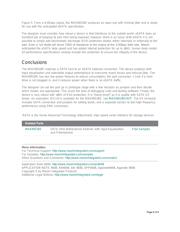下载

Maxim > Design Support > Technical Documents > Application Notes > High-Speed Signal Processing > APP 4648
Maxim > Design Support > Technical Documents > Application Notes > Interface Circuits > APP 4648
Maxim > Design Support > Technical Documents > Application Notes > Storage Products > APP 4648
Keywords: eSATA, equalization, pre-emphasis
APPLICATION NOTE 4648
New Equalized SATA I/II/III Redriver Improves
eSATA Cable Drive
May 15, 2012
Abstract: The MAX4951BE SATA I/II/III bidirectional redriver features input equalization, preemphasis,
and two new low-power modes. This device allows long runs of FR-4 or flex cable to be part of the
system, which still meets required eSATA compliance points. The MAX4951BE overcomes the issues of
matching a SATA host to an eSATA external connection.
Introduction
SATA¹ has become the ubiquitous connection to hard drives in both laptops and desktop PCs. SATA is
available in two basic forms, internal and external (eSATA). Both forms use seven conductor cables with
two balanced pairs and grounds between the pairs. In addition, eSATA can be used for runs up to 2m in
length and adds shielding to the cable. Many laptops and desktop computers have an eSATA connector
to be used with an eSATA drive. Current data rates of 3.0Gbps can transfer data up to 10x the speed of
USB 2.0 drives. Unlike the ungainly parallel cables, SATA and eSATA cables are thin and flexible, and
relatively easy to handle.
Challenge of Connecting an eSATA Port to a SATA Connection
SATA and eSATA transfer data at 3.0Gbps, or 300Mbps. The eSATA signal is usually derived from a
standard internal SATA port. This signal is propagated down a PC board and sent to an eSATA
connector. Many hosts do not have the drive capabilities to accommodate the losses of the board,
connector, and cable.
The MAX4951BE overcomes the issues of mating an eSATA port to a SATA connection. The
MAX4951BE drives the eSATA cable and enhances the signals in both directions through equalization.
Input equalization (EQ) and output preemphasis (PE) both improve the signal quality. Both board traces
and cables exhibit a lowpass filter characteristic; a typical board or cable can exhibit a -3dB point at
600MHz. Since the board or cable losses are frequency dependent, the ideal match would be a device
that compensates for the high-frequency losses. With eSATA, the system must deal with signals moving
in two directions: one signal goes from the host to the storage device, and one returns from the storage
device to the host.
Page 1 of 6








